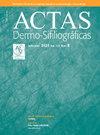重新定义奥玛单抗停药治疗慢性自发性荨麻疹:优化和复发预测因素的价值。52周多中心研究
IF 2.8
Q1 DERMATOLOGY
引用次数: 0
摘要
背景:慢性自发性荨麻疹患者在停用奥玛单抗后经常复发,需要重新引入。虽然先验优化可能会减少递归,但关于这个问题的证据很少。此外;在暂停前未优化的患者中已经确定了复发的预测因子。方法:我们进行了一项多中心回顾性研究,研究对象是在优化后12个月随访时停用奥玛单抗的患者。进行单因素和多因素(树分类法和Cox回归)分析。结果:共纳入131例患者,12个月后复发的占32.8%。复发患者病程更长(24.00个月vs 11.00个月;P = 0.032),标准剂量反应更快(1.00 vs 3.00个月;P = 0.014),优化前完成应答较少(83.70% vs 95.50%;P = 0.023), 300 mg/4周的治疗时间较短(6个月vs 7个月;P = 0.035)。多因素分析显示,基线c反应蛋白(CRP)和总免疫球蛋白E (IgE)较低的患者在接受长期治疗后,更有可能在12个月时维持持续缓解。结论:优化治疗可降低停药后复发率。与复发最相关的因素是不同剂量奥玛单抗治疗的持续时间,以及基线CRP和总IgE水平。为了尽量减少停药后的复发,建议以300 mg/4周的剂量进行12个月的治疗方案,然后在18个月的剂量逐渐减少。本文章由计算机程序翻译,如有差异,请以英文原文为准。
![[Artículo traducido] Redefiniendo la retirada de omalizumab en pacientes con urticaria crónica espontánea: el valor de la optimización y de los biomarcadores de recurrencia](https://img.booksci.cn/booksciimg/2025-7/102305700051784046936.jpg)
[Artículo traducido] Redefiniendo la retirada de omalizumab en pacientes con urticaria crónica espontánea: el valor de la optimización y de los biomarcadores de recurrencia
Background
Patients with chronic spontaneous urticaria frequently relapse after discontinuing omalizumab and require its reintroduction. Although prior optimization might reduce recurrences, there is scarce evidence on this issue. Moreover, predictors of relapse have been identified in non-optimized patients before suspension.
Methods
We conducted a multicenter retrospective study with patients who discontinued omalizumab after optimization with a 12-month follow-up. Univariate and multivariate (tree classification method and Cox regression) analyses were performed.
Results
A total of 131 patients were included, 32.8% of whom relapsed after 12 months. Relapsed patients had longer disease duration (24.00 vs 11.00 months; p = 0.032), quicker response to standard dosage (1.00 vs. 3.00 months; p = 0.014), fewer complete responses pre-optimization (83.70% vs 95.50%; p = 0.023), and shorter treatment duration at 300 mg/4 weeks (6 vs 7 months; p = 0.035). Multivariate analysis revealed that patients with elevated baseline C-reactive protein (CRP) and low total immunoglobulin E (IgE) who underwent prolonged treatment were more likely to maintain a sustained remission at 12 months.
Conclusion
Optimization seems to reduce the relapse rate after discontinuation. The most relevant factors for recurrence are associated with the duration of treatment at different doses of omalizumab, along with the baseline CRP and total IgE levels. To minimize relapse after suspension, a 12-month treatment regimen at 300 mg/4 weeks followed by an 18-month dose tapering is proposed.
求助全文
通过发布文献求助,成功后即可免费获取论文全文。
去求助
来源期刊

Actas dermo-sifiliograficas
DERMATOLOGY-
CiteScore
1.90
自引率
9.40%
发文量
473
审稿时长
56 weeks
期刊介绍:
Actas Dermo-Sifiliográficas, publicación Oficial de la Academia Española de Dermatología y Venereología, es una revista de prestigio consolidado. Creada en 1909, es la revista mensual más antigua editada en España.En 2006 entró en Medline, y hoy resulta imprescindible para estar al día sobre la dermatología española y mundial.
 求助内容:
求助内容: 应助结果提醒方式:
应助结果提醒方式:


